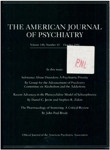Salivary prostaglandin concentrations: possible state indicators for major depression
Abstract
Salivary prostaglandin concentrations were determined in 42 patients with major depressive disorder, 16 patients with minor depressive disorder, and 39 healthy control subjects. The diagnoses were made according to the Research Diagnostic Criteria. The patients with major depressive disorder had higher salivary prostaglandin concentrations than the control subjects, but the patients with minor depressive disorder did not. Furthermore, the salivary prostaglandin concentrations of the patients with major depressive disorder showed a high correlation with the severity of the depression. These results suggest that high salivary prostaglandin concentrations may be state indicators for major depression.
Access content
To read the fulltext, please use one of the options below to sign in or purchase access.- Personal login
- Institutional Login
- Sign in via OpenAthens
- Register for access
-
Please login/register if you wish to pair your device and check access availability.
Not a subscriber?
PsychiatryOnline subscription options offer access to the DSM-5 library, books, journals, CME, and patient resources. This all-in-one virtual library provides psychiatrists and mental health professionals with key resources for diagnosis, treatment, research, and professional development.
Need more help? PsychiatryOnline Customer Service may be reached by emailing [email protected] or by calling 800-368-5777 (in the U.S.) or 703-907-7322 (outside the U.S.).



